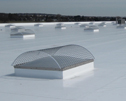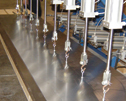Since the mid-1930s, Revere Copper Products Inc., Rome, N.Y. (which operated as Revere Copper and Brass Inc. until the early 1980s), has maintained its Technical Services Department to help architects, building owners, engineers and contractors with construction problems involving the application of its building products, including architectural sheet copper. I joined the Technical Services Department in 1968.
During my years with Revere Copper Products, problems presented to the company have mirrored the challenges and opportunities faced by the roofing industry. As architectural styles have changed, so have the uses of copper and, ultimately, the questions and problems presented to myself and Revere Copper Products' other technical advisers.
Following is a look at the past, present and future of copper.
A brief history
During the early part of the 20th century, a significant percent of copper installations were large built-in gutters, cornice covers, standing-seam parapet linings and other similar applications. During this time, the Copper and Brass Research Association (CABRA) released Copper Flashings, which stated: "Copper must be considered a 'live' metal; i.e., one which not only moves under temperature variations, but also has a large amount of ductility and tenacity. It is this characteristic which allows the metal to 'flow' while adjusting itself to temperature stresses (and prevents failure)."
However, there were problems—often involving splits and tears in the metal—that resulted in leaks. Recently installed copper projects were failing sooner and more often than ones installed during the 19th century, and it widely was believed "modern" methods of making copper resulted in a product that was inferior to older sheet copper.
According to CABRA, there was no problem with the copper but a majority of failures were, as stated in Copper Flashings, "the result of improper installation and failure to observe (the rule) Never secure copper in a manner which will prevent its free movement."
That's good advice but, as investigations and tests by Revere Copper Products proved, not the whole answer. Gauge, shape, temper and recognition of columnar rigidity are equally important in the design and installation of durable, maintenance-free copper.
In April 1945, Revere Copper Products published its first edition of Copper and Common Sense. In addition to presenting the results of almost 10 years of research regarding causes of copper failures, the publication contained 30 pages of details showing the simplest and most practical methods of installing copper and illustrating some basic principles governing the proper use of sheet copper. (The current edition of Copper and Common Sense—its eighth—was published in 2005.)
The information presented in the first edition was neither immediately nor universally accepted. Many in the building industry were unconvinced that changing from 16-ounce soft copper (roofing temper) to heavier, more rigid cold-rolled copper (cornice temper) was warranted. After all, soft copper had been the standard for hundreds—if not thousands—of years.
Despite initial skepticism, contractors who switched from soft to cold-rolled copper had no great difficulties forming or installing cold-rolled copper. They further discovered that by adhering to the principles in Copper and Common Sense, they reduced callbacks; installing the copper correctly the first time was more profitable.
By the time I joined Revere Copper Products in November 1968, Copper and Common Sense was 23 years old. The roofing industry generally understood and accepted the publication's principles. Nevertheless, challenges and opportunities for roofing contractors continued to change as architectural styles and uses of copper evolved.
In some cases, markets shrunk or disappeared entirely. Cornice covers faded into history; large built-in gutters became less popular; and contractor-formed expansion joint flashing quickly was replaced by pre-manufactured expansion joint products.
At the same time, new products and uses for copper were being explored. Twelve-ounce high-yield copper was introduced to compete with lightweight stainless steel. Copper-laminated panels (copper adhesively bonded to plywood and other substrates) were offered as a "labor-saving" innovation.
The 1970s saw rapid growth in the amount of copper used to manufacture flat-plate solar collectors. In addition to providing domestic hot water, solar collectors were used for space heating and cooling. Demonstration projects such as the Decade 80 House in Tucson, Ariz., which was designed and built by the Copper Development Association (CDA) Inc. in the mid-1970s, proved solar power's technical viability.
The solar industry offered opportunities for roofing contractors to expand their businesses by installing solar collectors, hot water systems (collectors, storage tanks, pumps, etc.) and integrated roof/collector systems. However, it also presented challenges: Would roofing workers become plumbers and vice versa, or was a new breed of contractor—one with little or no roofing experience—going to begin poking holes in roof systems (a situation not terribly unlike our current one, where electricians and landscaping contractors are crawling around on roofs)?
Although the solar movement definitely was a darling of the Carter administration, it was economically practical only when supported with federal tax credits. The Reagan administration's elimination of the alternative-energy credit effectively killed the market for copper solar collectors. As spectacular as the solar industry's growth was, its decline was equally swift.
The 1980 demise of the solar industry may have been little more than a blip on the radar for most in the roofing industry, but it was a major event for the copper industry—in 1979, Revere Copper Products had three plants manufacturing solar collectors; in 1981, it had none.
Innovations in the 1970s—the portable pan former and power seamer, for example—opened new markets for roofing contractors. Developed and introduced by Ewald Stellrecht in 1976, these machines so drastically changed metal roofing that many architects and contractors are unaware that less than 40 years ago, most copper roof panels were formed from sheets on sheet-metal brakes.
During the 1980s, problems presented to us involved typical structural, design and weatherproofing issues: a gutter may have been incorrectly specified, soldered seams may have broken, etc. Occasionally we were asked about lightning protection, how to artificially age copper, and compatibility of underlayments or sealants.
Aesthetics are important in these applications, but copper typically is selected for its weathertightness, durability and freedom from maintenance—its traditional selling points. When copper was installed properly, there were few callbacks.
Then, during the late 1980s and early 1990s, we began to receive more calls about copper's appearance rather than its durability or function. These calls often were from roofing contractors whose work had been rejected because the copper turned black, a roof exhibited oil canning (lack of visual flatness) or the copper did not meet the architect's expectations for some other aesthetic quality.
Not only did the nature of the problems change, but so did the types of buildings on which copper was being installed.
I am unaware of a study that quantifies the historic use of sheet copper in construction, but based on personal experience, I suspect that until about 20 years ago most sheet copper was used for flashings, rainwater goods and roofing (probably in that order); most installations were on governmental and institutional structures. Little sheet copper was used on private residences, and almost none was used as wall cladding.
Beginning in the late 1980s, changes in the economy and architectural styles presented new opportunities for roofing contractors and the copper industry. Although copper continued to be installed in a typical manner on "customary" projects, more residences were being roofed with copper. With this new market came new customers—the residential architect and homeowner—and new challenges.
Many architects and building owners were unfamiliar with copper's properties and how it weathers. Some believed it would remain bright and shiny indefinitely; others expected it to weather in a uniform, predictable manner; and still others wanted to maintain a particular shade or hue they had seen in a weathering chart. Practically all were shocked and upset when copper tarnished or took on an uneven purple or black coloration. Handprints, fingerprints, minor scratches and similar "irregularities" also were sources of complaints.
Additionally, many architects and building owners expected their copper roofs to appear uniformly flat and smooth. They were unhappy when oil canning was present.
Unfortunately, many roofing contractors involved with these projects had little or no experience with copper. What they knew—or thought they knew—often was based on inaccurate information. As a result, in their efforts to solve problems, they occasionally exacerbated them.
Weathering
Copper is an active metal. When exposed to the elements, it develops an oxide film. As time passes, the film deepens and copper darkens, becoming more uniform in color. If a portion of an oxidized surface is cleaned (to remove fingerprints, for example) the film will be removed and new, unoxidized copper exposed.
Such newly exposed copper is extremely active; it will begin to oxidize immediately but usually at a rate different from the adjacent, uncleaned copper. It is not unusual for cleaned copper to develop an iridescent tarnish overnight. Therefore, cleaning often replaces one unacceptable color with another equally unacceptable color.
So what should you do if an architect or building owner asks you to clean a copper roof? Revere Copper Products suggests doing nothing. Allow the copper to weather naturally. Fingerprints and scratches will blend and disappear as the oxides form; tarnish and unevenness will fade and be replaced with a brown or statuary color. If an architect or owner insists that copper be cleaned, contact the copper manufacturer for assistance before undertaking any cleaning.
Oil canning
Oil canning is inherent with all architectural sheet metal types. Although oil canning's degree and severity vary among applications, it is nearly impossible to guarantee any architectural sheet metal shape will appear totally flat in all environmental conditions. Although most roofing contractors are aware of this, I still am surprised by how many get trapped by specification language stipulating "no oil canning."
So what should you do when you encounter a specification prohibiting oil canning? You can advise the architect and building owner what is realistic before proceeding, but all too often, concerns regarding oil canning are not raised until after an installation is complete. In such cases, perhaps the best you can do is contact the copper manufacturer and NRCA for assistance with explaining the sheet metal's nature.
Finish and patina
When asked how to artificially age, patinate or otherwise color copper, Revere Copper Products' answer always is: Do not attempt it.
Patina development on copper is a chemical reaction. As with most chemical reactions, the process depends on many variables and can be affected by minor environmental changes, the presence of trace elements, etc.
The primary problem associated with coloring copper in the field is weather conditions, which are critical during and after chemical application. If conditions are too warm, cool, wet or dry, a coloring's aesthetics, quality and durability can be compromised. If the copper is not properly and completely prepared (either by cleaning or other methods—preparing copper for coloring often is hit-or-miss and involves dumb luck) or if additional compounds are inadvertently added by wind, for example, the results often are unsatisfactory and no one is happy with the end product.
What should you do when faced with a specification that requires artificially aging copper? Revere Copper Products suggests retaining a professional metal finishing contractor. Metal finishing is more art than science and best left to those who have proven track records.
Soldering
Revere Copper Products often is contacted about problems involving soldered seams in gutters or on flat-seam roofs. Typically, the question is: "How can cracks in a soldered seam be repaired?"
Unfortunately, there is no good answer. Cracks in soldered seams are not merely a surface condition. Rather, they are evidence of a fracture or break through the seam.
A fully sweated, 3/4-inch, locked and soldered seam in 16- or 20-ounce copper is stronger than the copper. In other words, when force is exerted on the seam, the copper away from the seam will fail before the seam breaks.
When soldered seams break, moisture and dirt are drawn into them, causing the metals (base and solder) to oxidize. The addition of flux, heat and solder to the outside of a broken seam will neither clean the metal inside the seam nor cause solder to flow through it. Piling solder over the crack may temporarily hide it, but it will not repair it.
When it comes to cracked soldered seams, what I recommend is not simple and certainly not what most roofing contractors want to hear: For gutters and certain flashings, open the seam, mechanically clean (wire brush) the copper, and re-form, flux and re-solder the seam. For flat-seam roofs, replace the installation.
If you wish to improve your soldering skills, the CDA offers installer training programs; information about the programs is available at www.copper.org.
Design
Thirty years ago, standing-seam copper roof systems essentially were confined to slopes of 3-in-12 (14 degrees) or greater. Eight- or 10-foot-long roof panels were formed on sheet-metal brakes; roof runs usually were 30 feet long or less.
Such roofs may have been unexciting, but they were weathertight and durable.
As with many construction elements, designers have pushed the limits of copper roofing during the years. Slopes have been reduced and runs extended. Now, it is not unusual for a roofing contractor to be asked to install a standing-seam copper roof system on a 1-in-12 (5-degree) slope with runs of 70 feet or more.
How is weathertightness maintained and normal expansion movement accommodated for on such a roof system?
There are no standard answers to these questions. Each project should be considered individually, taking into account local environmental conditions, the structure's use, construction methods and materials, etc. Revere Copper Products provides assistance to contractors whenever possible, but in the end, there are some designs for which standing-seam copper is not suitable and other materials and/or designs should be considered.
The environment
If someone had asked me six or seven years ago about copper's effects on the environment, I probably would have shrugged and asked, "What do you mean?" After all, copper is a natural material; its durability and long life are well-documented; architectural copper is made from recycled scrap material; and most drinking water in the U.S. is conveyed through copper water tubes. How could a material be more environmentally friendly?
Then, Architectural Uses of Copper: An Evaluation of Storm Water Pollution Loads and BMPs was published, which implied a link between runoff from copper roofing and rainwater goods and elevated levels of copper in a watershed. Although the report was not based on fact or scientific study, it quickly and mistakenly was embraced by environmental activists. Almost overnight, several communities throughout the U.S. adopted ordinances to prohibit copper's use. (Subsequently, some communities rescinded or changed their ordinances and now permit the use of copper.)
Copper-related environmental issues usually are a challenge for the copper industry, not roofing contractors. In most cases with copper roofs, a contractor does not select the material he or she is installing; someone else does (such as a designer or building owner). Although that other person should ensure environmental issues are addressed, there may be times when you are questioned about a copper product you have installed. In those cases, I suggest contacting the manufacturer.
The copper industry has conducted tests and developed models to predict the amount of copper that may be in a roof's runoff. A copper manufacturer can work with a roofing contractor and local officials to determine what, if any, treatment of runoff is appropriate.
Opportunities
During the early 1990s, few buildings had copper or copper alloy wall cladding. Those that did typically used curtain-wall or storefront systems that offered little opportunity for roofing contractors.
Although it is impossible to trace contractor-formed copper wall cladding's origin to a single building, one of the early projects was The Class of 1959 Chapel at Harvard Business School, Cambridge, Mass. In 1992, John F. Shea Co. Inc., Matapan, Mass., installed pre-patinated copper on the exterior walls of the Moshe Safdie-designed structure. Since then, use of copper for wall cladding has grown exponentially.
Although flat-seam construction is the most popular method of applying copper to vertical walls, we have provided assistance to architects and contractors designing systems employing standing seams, batten seams and "slip seams." Interestingly, in addition to aesthetics and durability, economics is a reason walls are clad with copper. Although most people think of copper as a high-priced material, we have been told by several architects that the installed cost of a copper wall system can be less than the cost of masonry construction.
So what do I see in copper's future? Copper roofs and rainwater goods will continue to account for the majority of architectural copper use. Wall cladding will continue to grow in popularity, and new opportunities and uses for copper will emerge.
David L. Hunt is manager—architectural services for Revere Copper Products Inc., Rome, N.Y.
A rich history
Revere Copper Products Inc. is one of the oldest, if not the oldest, manufacturing companies in the U.S. The company was founded by Paul Revere, the prominent patriot and silversmith, when he built the U.S.' first copper rolling mill in Canton, Mass., in 1801.
During the years, the company grew and its name changed. From the mid-1930s to the early 1980s, it operated as Revere Copper and Brass Inc.
Currently, Revere Copper Products is a privately owned corporation whose only shareholders are its employees.



